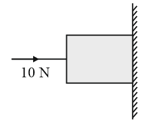Embibe Experts Solutions for Chapter: Laws of Motion, Exercise 2: Exercise 2
Embibe Experts Physics Solutions for Exercise - Embibe Experts Solutions for Chapter: Laws of Motion, Exercise 2: Exercise 2
Attempt the free practice questions on Chapter 1: Laws of Motion, Exercise 2: Exercise 2 with hints and solutions to strengthen your understanding. Comprehensive Guide to TS EAMCET Physics. Other applicable Exams - JEE Main, VITEEE, SRM JEE, MHT-CET, K-CET, BITSAT, AMU & Other State Engg. Entrance Exams solutions are prepared by Experienced Embibe Experts.
Questions from Embibe Experts Solutions for Chapter: Laws of Motion, Exercise 2: Exercise 2 with Hints & Solutions
A body of mass moving with a uniform velocity of . If the value of is , then the force acting on the frictionless horizontal surface on which the body is moving is
A weight rests on a rough horizontal plane. If the angle of friction be , the least horizontal force that will move the body along the plane will be
A particle moves so that its acceleration is always twice its velocity. If its initial velocity is , its velocity after it has gone is
A horizontal force of is necessary to just hold a block stationary against a wall. The coefficient of friction between the block and the wall is . The weight of the block is

In an explosion, a body breaks up into two pieces of unequal masses. In this
The force required to just move a body up the inclined plane is double the force required to just prevent the body from sliding down the plane. The coefficient of friction is The inclination of the plane is
If and are coefficients of static friction, sliding friction and rolling friction, then
A block is at rest on an inclined plane making an angle with the horizontal. As the angle of the inclination is increased, the block just starts slipping when the angle of inclination becomes . Then the coefficient of static friction between the block and the surface of the inclined plane is
